Sri Lanka is a diverse paradise with varied habitats that offer refugees to a wide variety of migratory bird species. Migrant birds in Sri Lanka are commonly seen in forests, wetlands, lakes, and agricultural lands.
Although the numbers of these birds show fluctuations every year, there is a consistent number of migrating birds that flock the island every year. Bird enthusiasts and bird watchers from all over the world travel to Sri Lanka to observe these beautiful migratory birds.
In this article, we will explore the list of migratory birds that visit Sri Lanka and discuss their migratory patterns and habits.
1. Chestnut-Winged Cuckoo
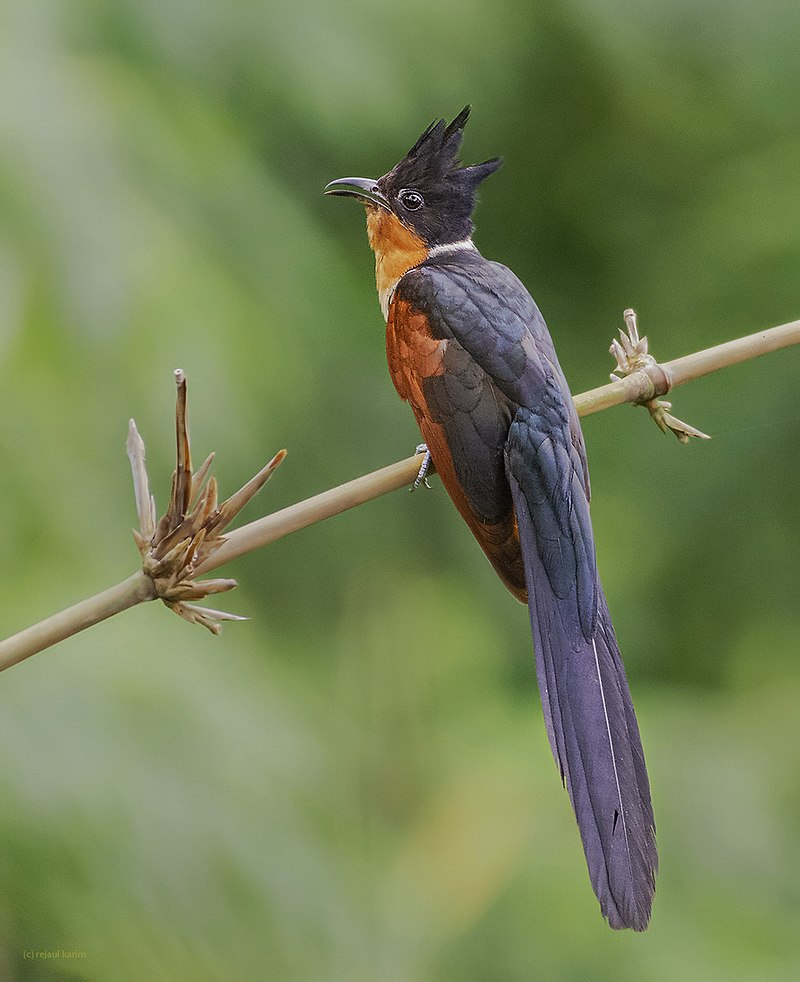
The Chestnut-winged cuckoo is a beautiful bird found in Southeast Asia and parts of South Asia.
It has glossy black head with long crest, chestnut wings, rufous throat and dusky underside as well as narrow white nuchal half collar which make it distinct from other birds.
It breeds along the Himalayas during summer season and migrates south to Sri Lanka during winter season.
This species prefers dense forest habitat but can also be seen in open woodlands or grassland areas where they feed on small invertebrates such insects and worms.
They are known for their loud calls that are heard throughout the day especially early morning when they seek mates or announce territory presence.
Scientific classification:
| Kingdom | Animalia |
| Phylum | Chordata |
| Class | Aves |
| Order | Cuculiformes |
| Family | Cuculidae |
| Genus | Clamator |
| Species | C. coromandus |
Also Featured In: Common Birds in India, Guam Birds You Need to See
2. Indian Spot-Billed Duck
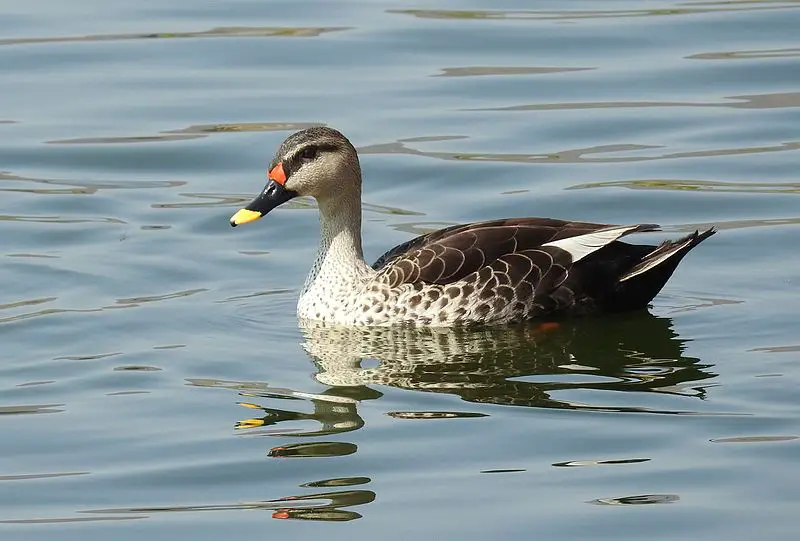
The Indian spot-billed duck is a large dabbling duck found throughout freshwater wetlands in the Indian subcontinent. It gets its name from the red spot at the base of its bill, which is only seen on mainland birds.
Distinctive white tertials form a stripe down their sides, making it easy to recognize them even when far away.
They feed mainly on aquatic vegetation and invertebrates including molluscs and insects but will also consume some grains and fruits during dry seasons or if food becomes scarce.
When not breeding they can be found in flocks with other ducks such as teals or pochards.
Breeding season varies by region but typically takes place between March–May, where pairs build nests close to water usually among reeds or grasses lining ponds, marshes, rivers etc..
The female incubates her eggs for around 24 days before hatching occurs; afterwards both parents care for their young until they fledge after 45-50 days old.
Scientific classification:
| Kingdom | Animalia |
| Phylum | Chordata |
| Class | Aves |
| Order | Anseriformes |
| Family | Anatidae |
| Genus | Anas |
| Species | A. poecilorhyncha |
Also Featured In: Native Pakistani Birds, Gujarati Birds
3. Indian Paradise Flycatcher
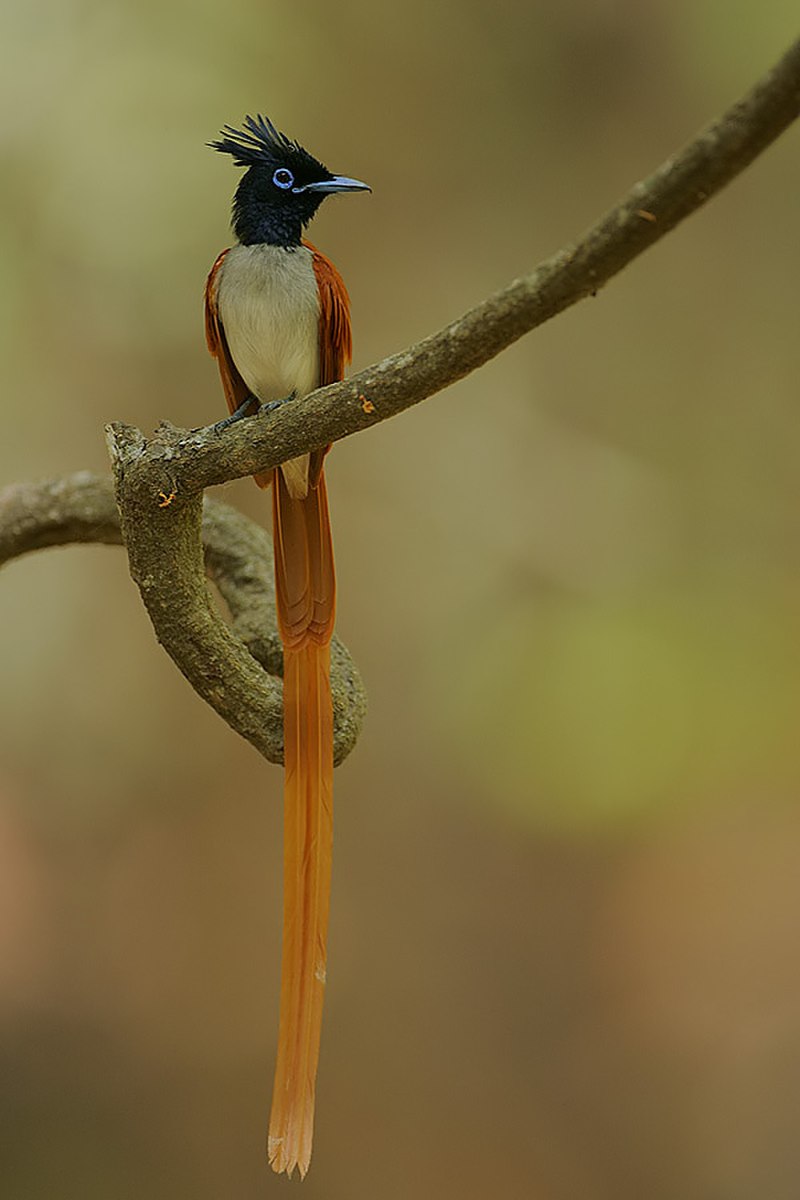
The Indian paradise flycatcher is a beautiful bird native to Asia. It has an overall black and rufous plumage, but the males have elongated central tail feathers that really stand out.
This species is considered stable globally, so it is listed as Least Concern on IUCN’s Red List of Threatened Species.
The range of this passerine extends from India in the South Asian subcontinent all the way up to Central Asia and Myanmar.
Despite its beauty, sadly these birds are also threatened by loss of habitat due to urbanization and deforestation caused by humans- we must do our best to protect them.
Scientific classification:
| Kingdom | Animalia |
| Phylum | Chordata |
| Class | Aves |
| Order | Passeriformes |
| Family | Monarchidae |
| Genus | Terpsiphone |
| Species | T. paradisi |
Also Featured In: Native Birds of Kazakhstan, Black And White Birds You Don’t Know About
4. Black-Capped Kingfisher
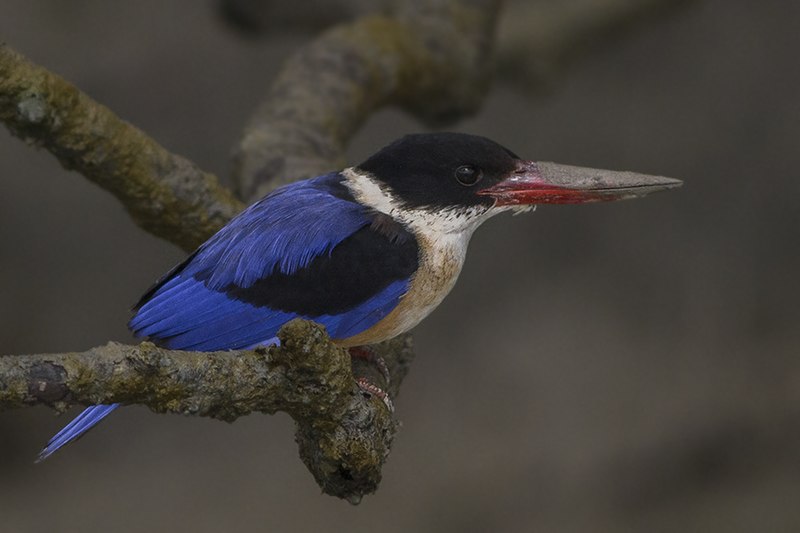
The Black-capped Kingfisher is a beautiful species of tree kingfishers found in tropical Asia from India east to China, Korea and Southeast Asia.
Its striking features include its black cap that contrasts with its bright blue back, wings and tail.
It has white underparts which makes it easily identifiable when perched atop trees or flying above the ground searching for food.
During winter months some northern populations migrate south seeking warmer climates such as Sri Lanka, Thailand, Borneo and Java.
The diet of this bird consists mainly of insects but may also feed on small reptiles like lizards or snakes if available.
They can be seen generally near water bodies where they hunt their prey by diving into the waters from a high perch.
Scientific classification:
| Kingdom | Animalia |
| Phylum | Chordata |
| Class | Aves |
| Order | Coraciiformes |
| Family | Alcedinidae |
| Subfamily | Halcyoninae |
| Genus | Halcyon |
| Species | H. pileata |
Also Featured In: Most Common Types of Bangladeshi Birds, Birds of Goa
5. Blue-Tailed Bee-Eater
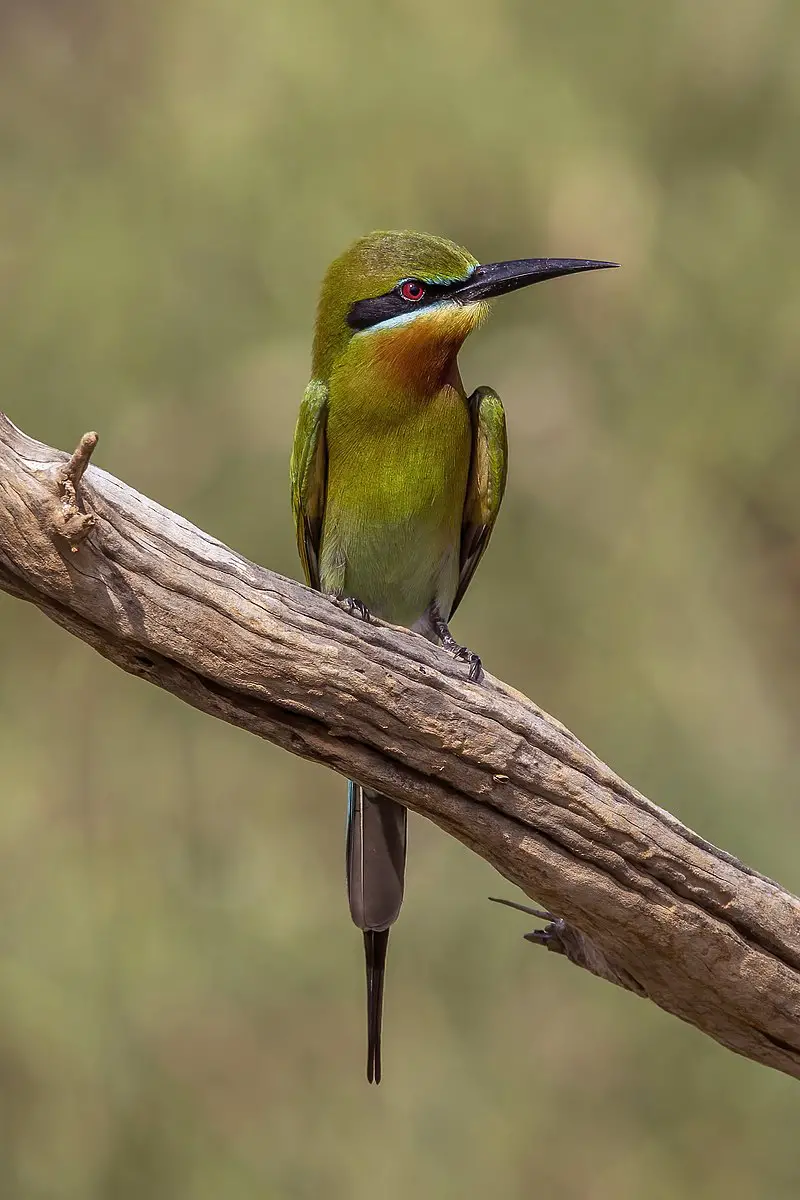
The Blue-tailed Bee-eater is a stunning bird found in South and Southeast Asia. This vibrant species has an iridescent blue tail, green back, yellow chest and white throat that stands out against the bright sky.
It feeds mainly on bees, wasps and other flying insects which it catches using its sharp beak while swooping through the air with remarkable agility.
The bee-eater typically nests by tunneling into loamy sand banks near rivers or streams to create burrows for their eggs.
During migration season they are often seen in large flocks soaring gracefully across the landscape seeking food sources before settling down in colonies during breeding season.
With its beautiful colours and graceful flight this impressive avian beauty captivates anyone lucky enough to see it up close.
Scientific classification:
| Kingdom | Animalia |
| Phylum | Chordata |
| Class | Aves |
| Order | Coraciiformes |
| Family | Meropidae |
| Genus | Merops |
| Species | M. philippinus |
Also Featured In: Birds of the Philippines, Common Philippines Birds
6. Black Baza
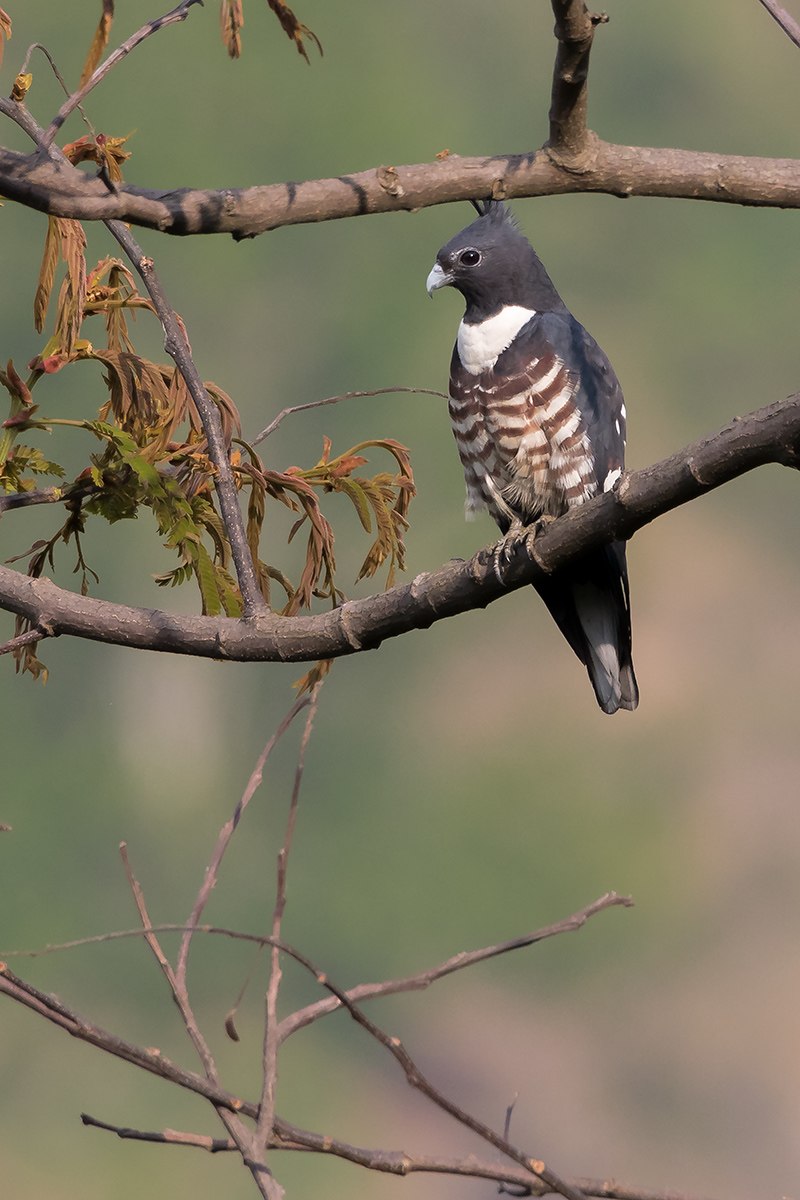
The Black Baza is a small bird of prey found in the forests of Northeast India, Eastern Himalayas. China and Southeast Asia. It has short stout legs with strong talons for gripping its prey and sports a prominent crest atop its head.
During winter season many populations migrate to south Peninsula and Sri Lanka where they can find food more easily than their native habitats dense forest areas.
The black bazas diet consists mainly of insects, lizards, small birds or mammals as well as fruits like figs which make up about 45% of what it eats during summer months when insect availability is low around them.
Scientific classification:
| Kingdom | Animalia |
| Phylum | Chordata |
| Class | Aves |
| Order | Accipitriformes |
| Family | Accipitridae |
| Genus | Aviceda |
| Species | A. leuphotes |
Also Featured In: Common Birds Found in Nepal, Common Birds of Indonesia
7. Kentish Plover
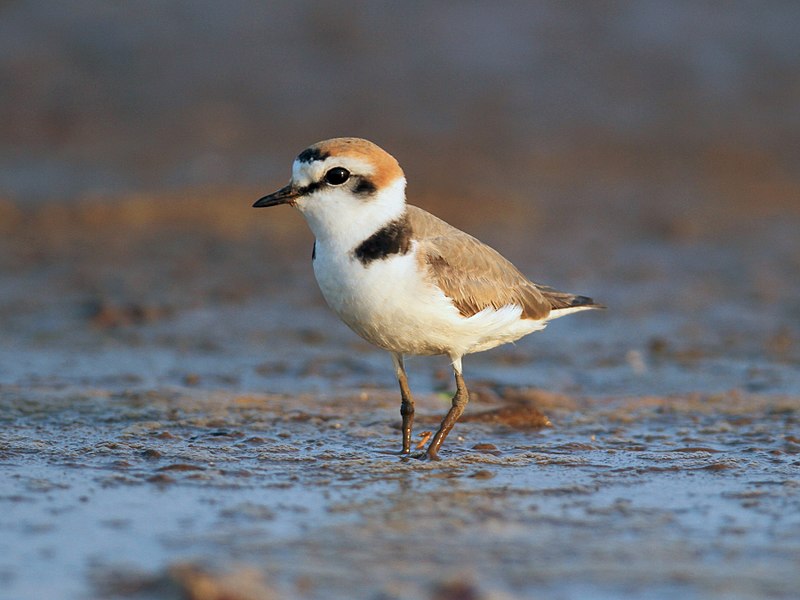
The Kentish plover is an elegant shorebird found around the world in coastal areas, saline lakes and lagoons. Both males and females have pale plumages with a white underside, grey/brown back, dark legs and a black bill.
The male birds however feature one extra distinction; they sport chestnut crowns on their heads.
During mating season the males are known to perform elaborate courtship displays – flying up high into the air before diving rapidly towards its partner while singing loudly.
They can be seen nesting among rocks or sand dunes close to water bodies where they use broken shells as building material for their nests.
This species of bird provides many benefits including controlling insect populations near coasts as well as providing food sources for larger predators such as raptors during migration times when prey is scarce.
Scientific classification:
| Kingdom | Animalia |
| Phylum | Chordata |
| Class | Aves |
| Order | Charadriiformes |
| Family | Charadriidae |
| Genus | Charadrius |
| Species | C. alexandrinus |
Also Featured In: Birds in Sri Lanka, Birds Found in Hungary
8. Common Redshank
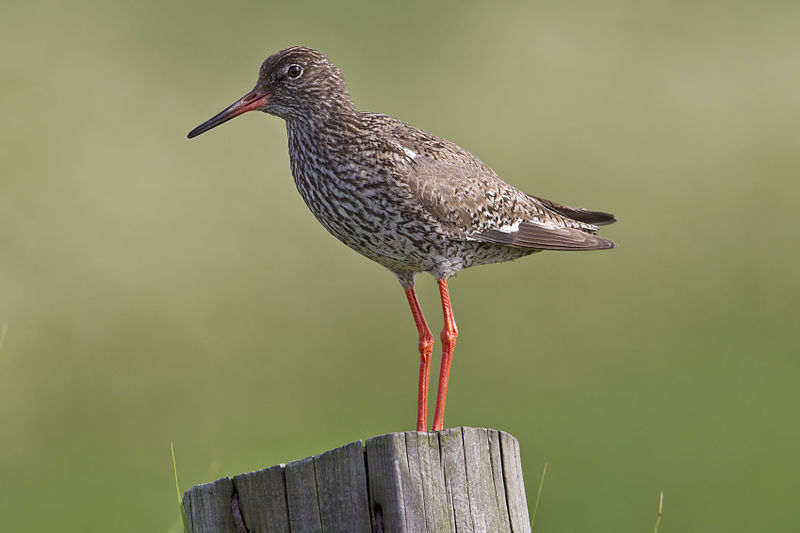
The Common Redshank is a wading bird found in Eurasia. It has long, red legs and dark grey wings. The body of the bird is brownish-grey with white patches on its sides and back.
Its bill is pointed and yellow to orange in colour, while its eyes are black or dark brown.
During migration they can be seen around coasts, estuaries and marshes where they feed mainly on small aquatic invertebrates such as worms, crustaceans and molluscs which it finds by probing mudflats with its bill.
They nest near wetland areas laying two to four eggs at a time during April or May depending on their location within Europe/Asia.
Redshanks often form large flocks when migrating southwards for wintering grounds in Africa or Asia making them easily visible from shorelines
Scientific classification:
| Kingdom | Animalia |
| Phylum | Chordata |
| Class | Aves |
| Order | Charadriiformes |
| Family | Scolopacidae |
| Genus | Tringa |
| Species | T. totanus |
Also Featured In: Birds of Orkney, Common Birds of Itsukushima
9. Black-Tailed Godwit
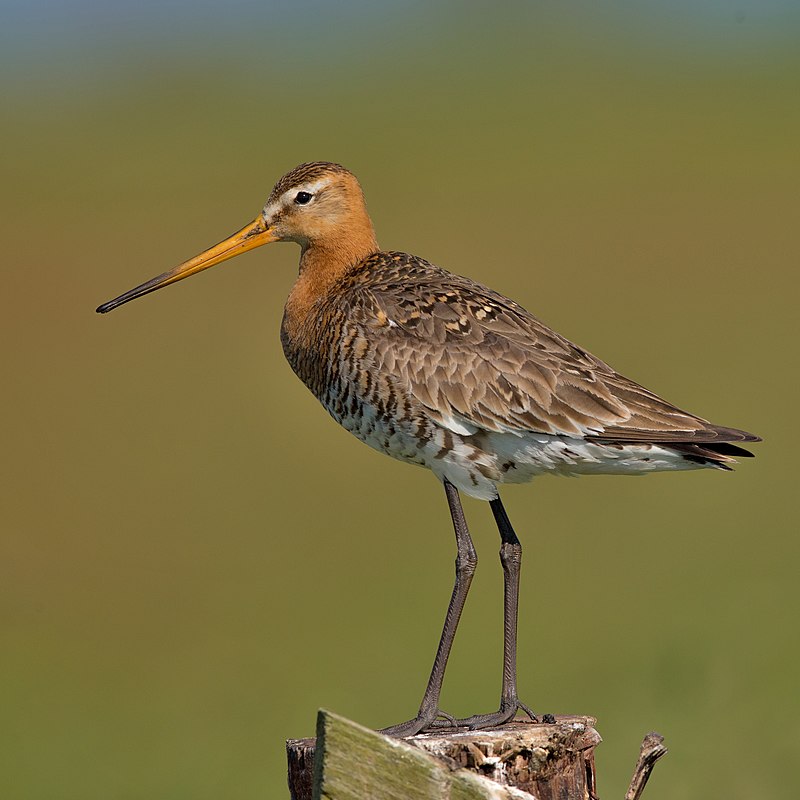
The Black-tailed Godwit is a species of large shorebird that was first described by Carl Linnaeus in 1758.
These beautiful birds have an orange head, neck and chest during breeding season while they turn to grey-brown coloration in winter.
They are easily identifiable due their black and white wingbar throughout the year. As for its habitat, these godwits breed mostly on Iceland but also across Europe, eastward through Asia Minor all the way to Mongolia; some even winter further south in Africa or India.
The Godwit has adapted well to human presence as it can be found close to wetlands near farms or villages where plenty of food is available from ploughed fields.
It’s really amazing how such a majestic bird with colorful plumage manages so successfully at this day and age.
Scientific classification:
| Kingdom | Animalia |
| Phylum | Chordata |
| Class | Aves |
| Order | Charadriiformes |
| Family | Scolopacidae |
| Genus | Limosa |
| Species | L. limosa |
Also Featured In: Belarus Birds You Should Know, Common Slovakian Birds
10. Pin-Tailed Snipe
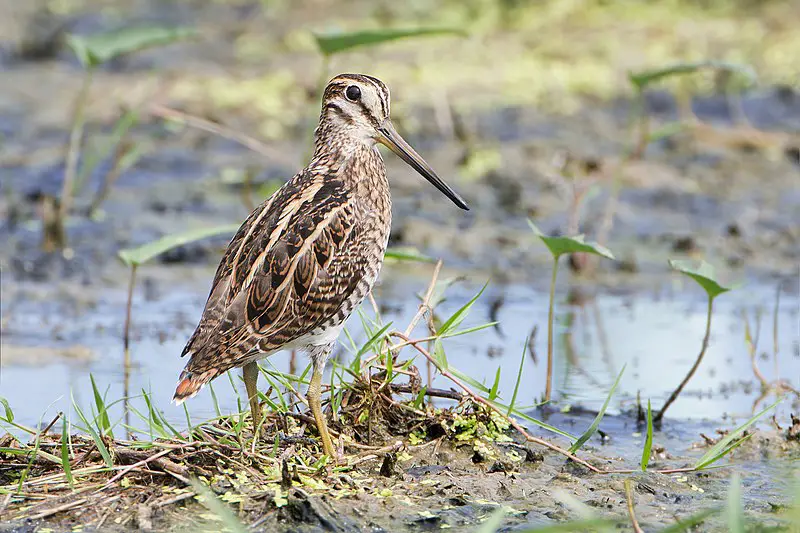
The Pin-tailed Snipe is a species of bird belonging to the family Scolopacidae. It breeds in northern Russia and migrates south during non-breeding seasons, travelling as far as Pakistan, Indonesia and even Australia.
This remarkable little bird has adapted well to its environment; it prefers wetland habitats such as marshes for breeding season and open grassy areas with low vegetation when migrating.
Its diet consists mainly of insects, worms and molluscs which are found on or near the ground amongst dense vegetation.
The pin-tailed snipe’s plumage helps camouflage it from predators while searching for food along damp grounds.
All in all this small yet resilient creature is an amazing example of evolution at work.
Scientific classification:
| Kingdom | Animalia |
| Phylum | Chordata |
| Class | Aves |
| Order | Charadriiformes |
| Family | Scolopacidae |
| Genus | Gallinago |
| Species | G. stenura |
Also Featured In: Birds that Commonly Found in Bali, Birds that Migrate in United Arab Emirates
11. Western Reef Heron
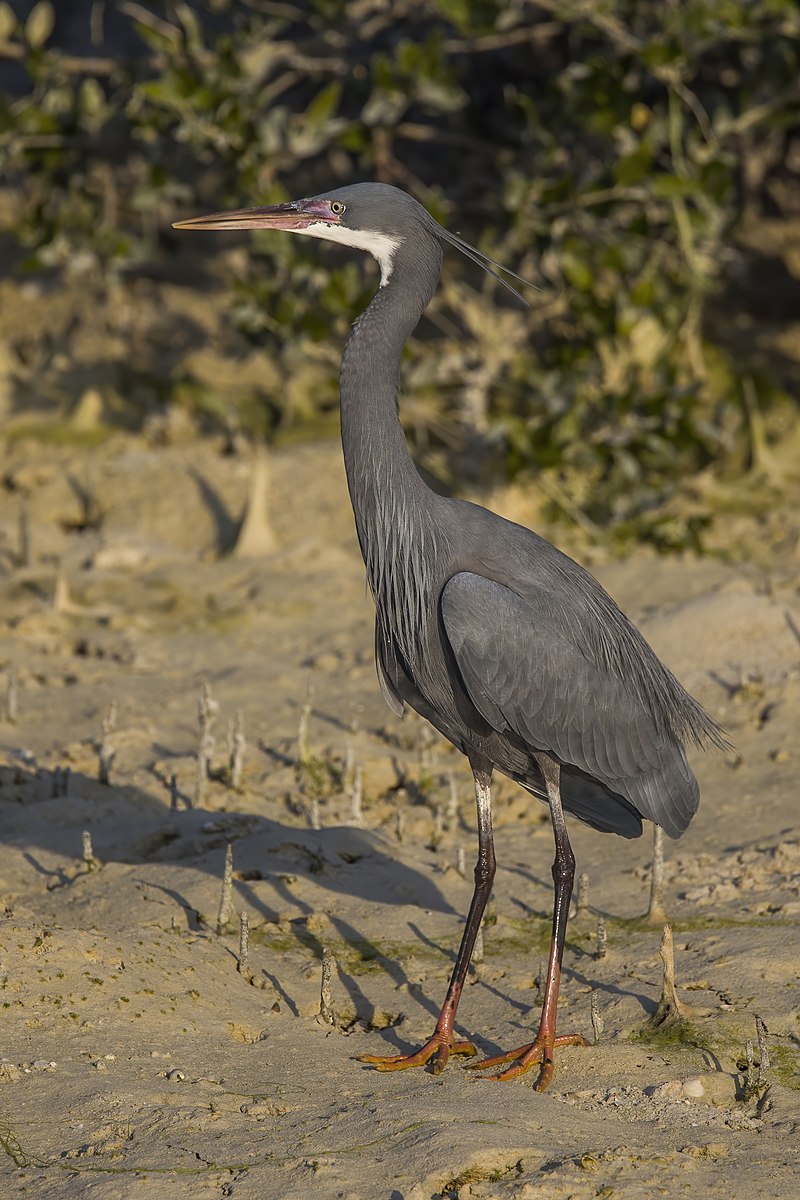
The western reef heron, also known as the western reef egret, is a medium-sized bird found in southern Europe, Africa and some parts of Asia. It usually inhabits coastal areas and has two distinctive plumage forms.
The slaty-grey form can be mistaken for the rare dark morph of the Little Egret while its white form looks similar to that of an immature Grey Heron.
This species feeds mainly on fish but will occasionally eat insects or other small aquatic animals like crabs and molluscs too.
Western Reef Herons are solitary birds that nest near water bodies where they build nests from sticks which may sometimes contain feathers or seaweed as well.
They have become endangered since their habitats have been destroyed due to human activities such as building developments along coastlines; however conservation efforts are being taken to ensure their survival into future generations.
Scientific classification:
| Kingdom | Animalia |
| Phylum | Chordata |
| Class | Aves |
| Order | Pelecaniformes |
| Family | Ardeidae |
| Genus | Egretta |
| Species | E. gularis |
Also Featured In: Birds of Senegal, Birds that Live in Benin
12. Spot-Billed Pelican
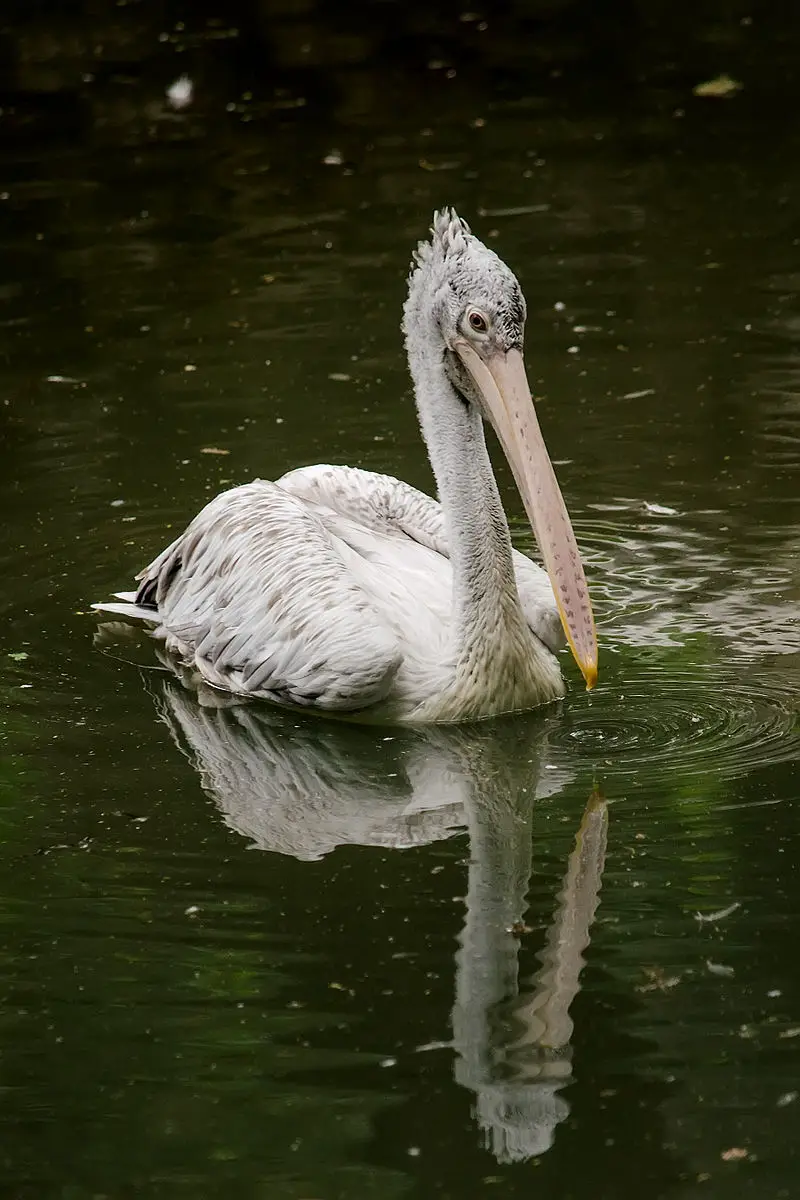
The Spot-billed Pelican is a species of the pelican family that lives in southern Asia, ranging from Iran to Indonesia. It prefers large inland and coastal waters like lakes.
These birds are quite small compared to other types of pelicans, making them difficult to identify from afar but their distinguishing feature is the spots on its bill which can be seen up close.
They feed mainly on fish by diving into water and scooping out prey with their long bills. During breeding season they build nests near bodies of water and lay two or three eggs per clutch.
The spot-billed pelican is an important part of local ecosystems as it helps keep populations of certain aquatic preys down while providing food for larger predators such as raptors and crocodiles.
Scientific classification:
| Kingdom | Animalia |
| Phylum | Chordata |
| Class | Aves |
| Order | Pelecaniformes |
| Family | Pelecanidae |
| Genus | Pelecanus |
| Species | P. philippensis |
Also Featured In: Birds of Cambodia, Birds of Karnataka
13. Brown-Headed Gull
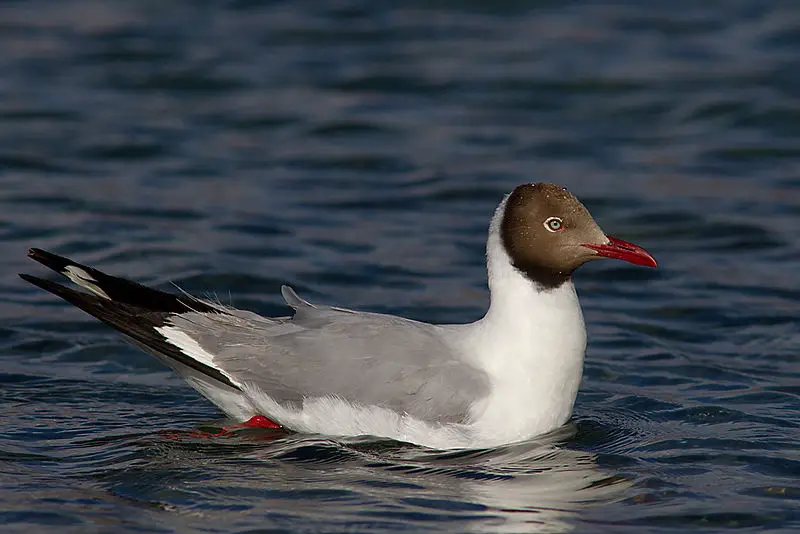
The Brown-headed Gull is a small species of gull that breeds in the high plateaus of Central Asia, from Tajikistan to Inner Mongolia.
During winter it migrates southward and can be seen along coastal areas and large inland lakes throughout the Indian Subcontinent.
They usually breed in colonies within reedbeds or marshes, constructing nests out of sticks on top of trees or among tall vegetation.
These birds have brown heads while their bodies are white with black wing tips; they also feature bright yellow eyes which give them an intense yet endearing look.
Their diet consists mainly fish but they’ll also consume insects, molluscs, crustaceans as well as other invertebrates and even plant matter during seasons when food is scarce.
Despite their shy nature towards humans these amazing birds make for wonderful wildlife watching opportunities.
Scientific classification:
| Kingdom | Animalia |
| Phylum | Chordata |
| Class | Aves |
| Order | Charadriiformes |
| Family | Laridae |
| Genus | Chroicocephalus |
| Species | C. brunnicephalus |
Also Featured In: Most Common Birds in Tajikistan, Birds of Ladakh
14. Lesser Sand Plover
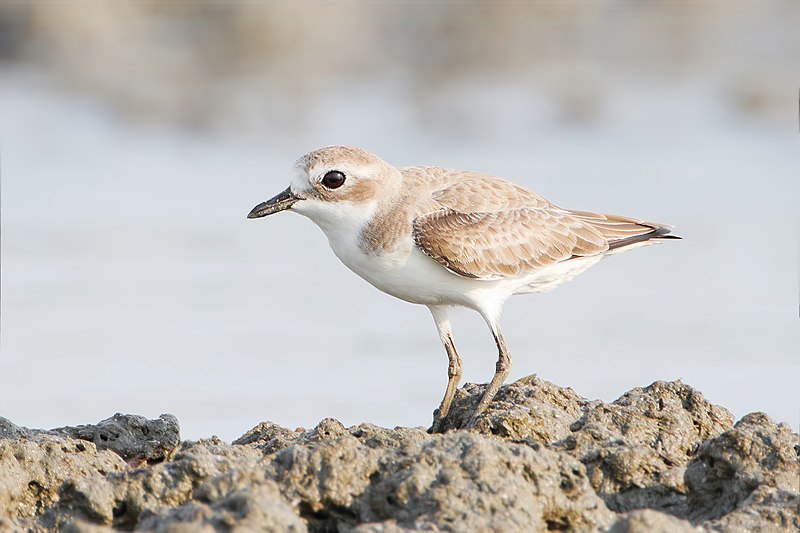
The Lesser Sand Plover is a small wader bird belonging to the plover family. It has yellowish-brown upperparts and white underparts, with a distinct black band across its chest and whitish forehead.
Its wings are short but powerful, allowing it to cover large distances in search of food such as insects, worms or crustaceans found on muddy beaches or shallow lagoons near coasts.
The species prefers habitats with low vegetation like sandy deserts, coastal dunes and salt flats where they can hide among the sand grains while foraging for food during their migrations between Africa and Asia.
These birds form monogamous pairs that breed annually in springtime; nests consist of scrapes made on the ground lined with pebbles or shells carefully arranged by both parents who will vigorously defend them against predators until chicks fledge after about four weeks from hatching.
Scientific classification:
| Kingdom | Animalia |
| Phylum | Chordata |
| Class | Aves |
| Order | Charadriiformes |
| Family | Charadriidae |
| Genus | Charadrius |
| Species | C. mongolus |
Also Featured In: Kyrgyzstan Birds, Common Republic of Nauru Birds
15. Garganey
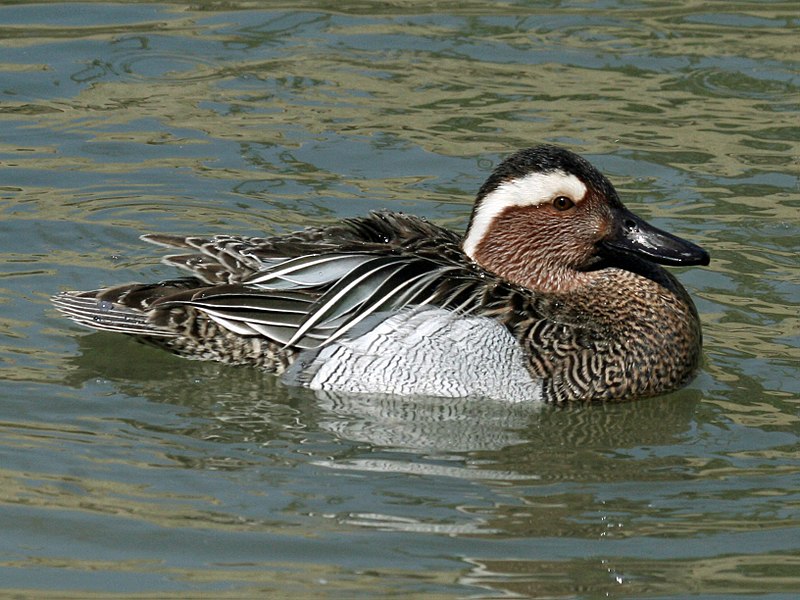
The Garganey is a small dabbling duck that breeds in much of Europe and across the Palearctic. During winter, it migrates to southern Africa, India (Santragachi), Bangladesh (in Sylhet district) and Australasia where large flocks can be seen.
It has an unmistakable appearance with its brownish head and grey body covered by white patches on both sides along with blue speculum feathers at the back of wings.
Its diet mostly consists of aquatic vegetation such as grasses, sedges or pondweeds which are usually collected from shallow waters like marshes or ponds while swimming.
The species is vulnerable due to loss of wetland habitats caused by drainage for agriculture purposes or urban development making them increasingly rarer throughout their range.
Scientific classification:
| Kingdom | Animalia |
| Phylum | Chordata |
| Class | Aves |
| Order | Anseriformes |
| Family | Anatidae |
| Genus | Spatula |
| Species | S. querquedula |
Also Featured In: Kuwait Birds, Birds That Live in Anglesey
16. White-Winged Tern
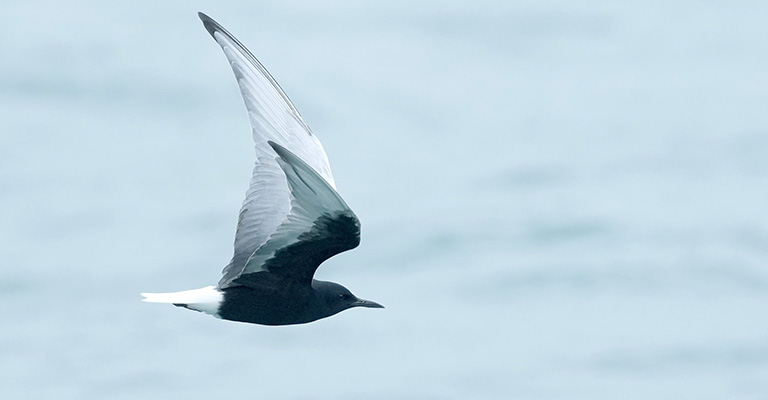
The White-winged Tern is a small species of tern found across much of the world, from Europe to Africa and Asia, inhabiting fresh water habitats.
With its scientific name Chlidonias leucopterus or Chlidonias leucoptera coming from Ancient Greek meaning ‘swallow-like’, it has white wings giving it an unmistakable appearance in flight.
It feeds on insects by swooping down over water surfaces at high speed and snatching them up with its beak while skimming the surface.
This bird also nests near bodies of freshwater such as lakes, rivers and marshes making use of reeds for cover against predators when they’re raising their chicks.
A beautiful sight to behold wherever they are found.
Scientific classification:
| Kingdom | Animalia |
| Phylum | Chordata |
| Class | Aves |
| Order | Charadriiformes |
| Family | Laridae |
| Genus | Chlidonias |
| Species | C. leucopterus |
Also Featured In: Bahrain birds, Birds You’ll Find in Albania
17. Curlew Sandpiper
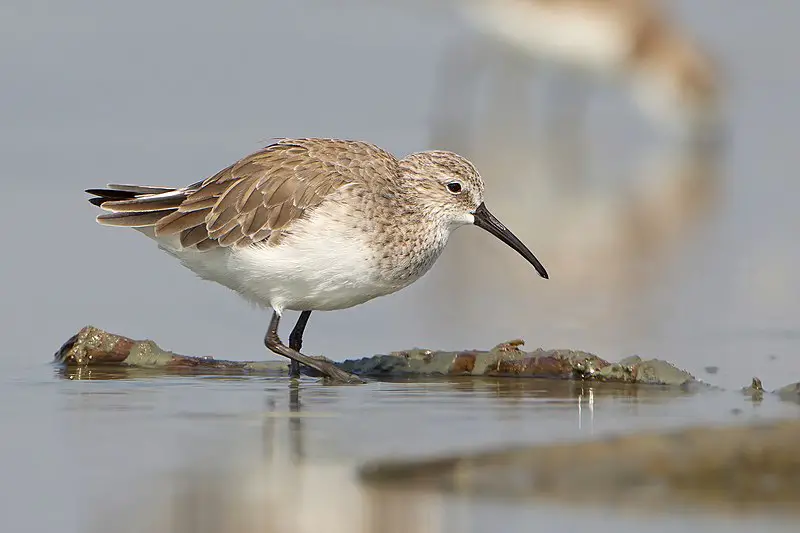
The Curlew Sandpiper is a small wader that breeds in the Arctic tundra of Siberia. It’s strongly migratory, wintering mainly in Africa but also found as far away as Australia and New Zealand.
This bird has been spotted occasionally on North American shores too. The species was first described by Erik Pontoppidan from Denmark back in 1763 under the scientific name Tringa ferrugineus.
Its plumage is predominantly grey-brown with white underneath which gives it its unique look among other sandpipers.
As one of the most long distance migrants known to science, this amazing creature will travel thousands of miles every year just for food and shelter.
Scientific classification:
| Kingdom | Animalia |
| Phylum | Chordata |
| Class | Aves |
| Order | Charadriiformes |
| Family | Scolopacidae |
| Genus | Calidris |
| Species | C. ferruginea |
Also Featured In: British Columbian Birds,
18. Brown Shrike
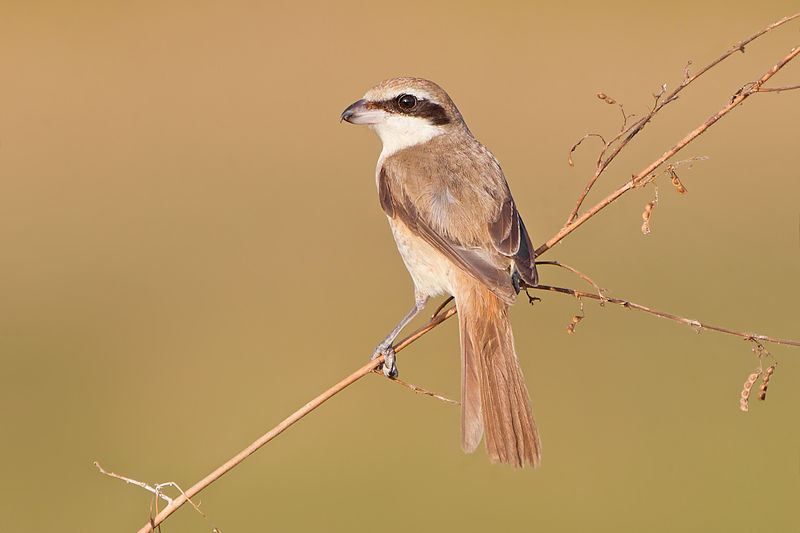
The Brown Shrike is a beautiful bird belonging to the shrike family, found mainly in Asia. It has a distinctive crest which gives it its Latin name ‘cristatus’.
They feed on insects and small vertebrates like lizards and mice, hence they are also called ‘butcher birds’.
These birds have brown upperparts with rufous wings, tail tipped white along with black mask through the eyes giving them an impressive look.
Despite their predatory nature these birds still remain quite popular amongst birdwatchers due to their vibrant colors and wide-ranging habitats across much of South East Asia making them easy targets for photography enthusiasts too.
Scientific classification:
| Kingdom | Animalia |
| Phylum | Chordata |
| Class | Aves |
| Order | Passeriformes |
| Family | Laniidae |
| Genus | Lanius |
| Species | L. cristatus |
Also Featured In: Maldives birds, Most Common Birds of Bihar
19. Oriental Hobby
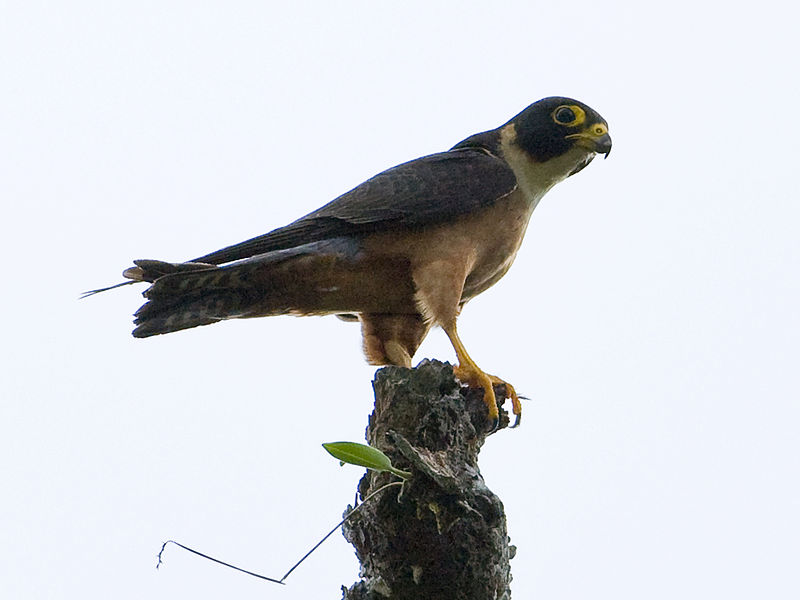
The Oriental Hobby is a species of falcon found across the northern parts of the Indian Subcontinent, eastern Himalayas and Indochina to Australasia.
It can reach up to 27-30 cm in length and has been observed as a vagrant from Malaysia.
This bird feeds mainly on insects and birds with rare instances where it catches bats too. Its coloring consists mostly of greyish brown above while its underside is light chestnut or buff tinged white or cream color with black spots along its belly area.
The male sports an additional patch of bluish slate above its tail which makes them easily distinguishable from female counterparts who lack this feature instead having gray barring at their tails end.
Scientific classification:
| Kingdom | Animalia |
| Phylum | Chordata |
| Class | Aves |
| Order | Falconiformes |
| Family | Falconidae |
| Genus | Falco |
| Species | F. severus |
Also Featured In: Falcons Species,
20. Red-Rumped Swallow
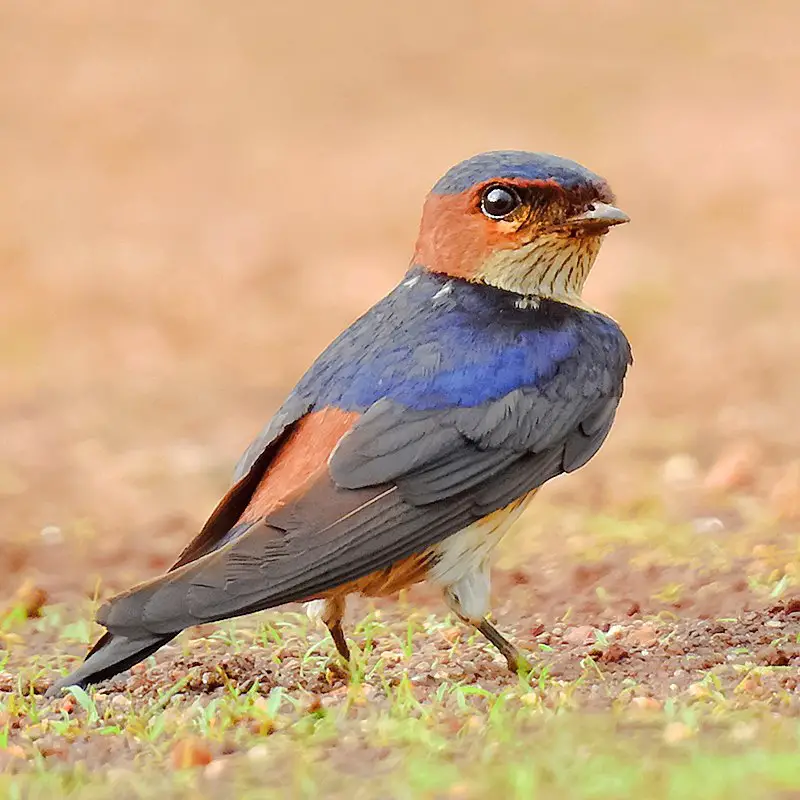
The Red-rumped Swallow is a beautiful bird of the swallow family that can be found in temperate southern Europe and Asia all the way from Portugal to Japan.
It breeds in open hilly country, while Indian and African birds are resident year round; however, European and other Asian swallows migrate south for winter to Africa or India.
These graceful creatures have even been observed as vagrants on Christmas Island. These small passerine birds are known for their striking red rumps which contrast against their otherwise dark blue plumage.
The diet of these swallows consist primarily of insects such as flies, bees, wasps etc., which they catch during short flights close to ground level.
So if you ever find yourself out in an open field near some hills this summer keep your eyes peeled for one of nature’s most stunning avian beauties -the Red-rumped Swallow.
Scientific classification:
| Kingdom | Animalia |
| Phylum | Chordata |
| Class | Aves |
| Order | Passeriformes |
| Family | Hirundinidae |
| Genus | Cecropis |
| Species | C. daurica |
Also Featured In: Swallows Species, Birds Live in Tunisia
21. Pacific Golden Plover
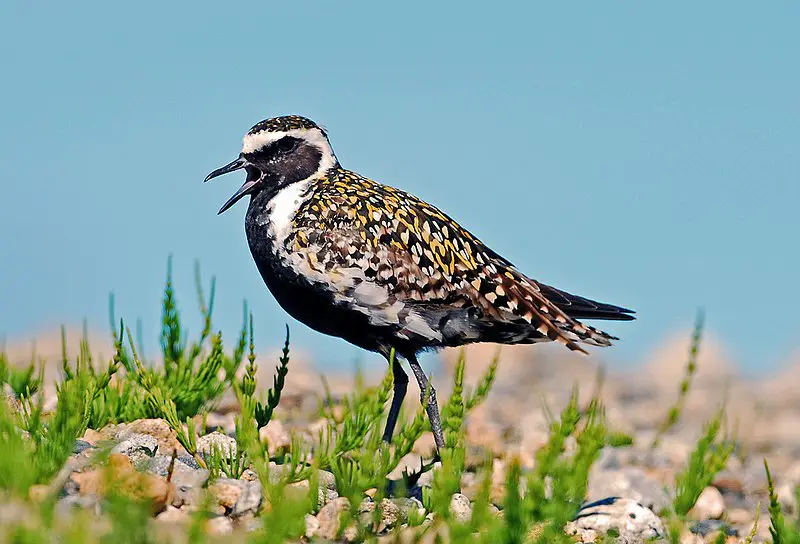
The Pacific golden plover (Pluvialis fulva) is an attractive migratory shorebird known for its breeding habits in Alaska and Siberia.
During the nonbreeding season, these medium-sized birds migrate widely across the Pacific.
It was formally described by Johann Friedrich Gmelin in 1789 as part of his revised edition of Carl Linnaeus’s Systema Naturae.
The species has a unique yellowish colouration with dark markings on their wings and back which gives them splendid camouflage against coastal rocks or sand beaches during migration periods.
They are omnivorous feeders who primarily eat insects, small crustaceans, worms and plant material like seeds or berries found along coastlines while migrating through various islands such as Hawaii, New Zealand etc.. A remarkable bird that possesses both beauty and resilience.
Scientific classification:
| Kingdom | Animalia |
| Phylum | Chordata |
| Class | Aves |
| Order | Charadriiformes |
| Family | Charadriidae |
| Genus | Pluvialis |
| Species | P. fulva |
Also Featured In: Hawaii Birds, Birds of Kauai, Hawaii
22. Marsh Sandpiper
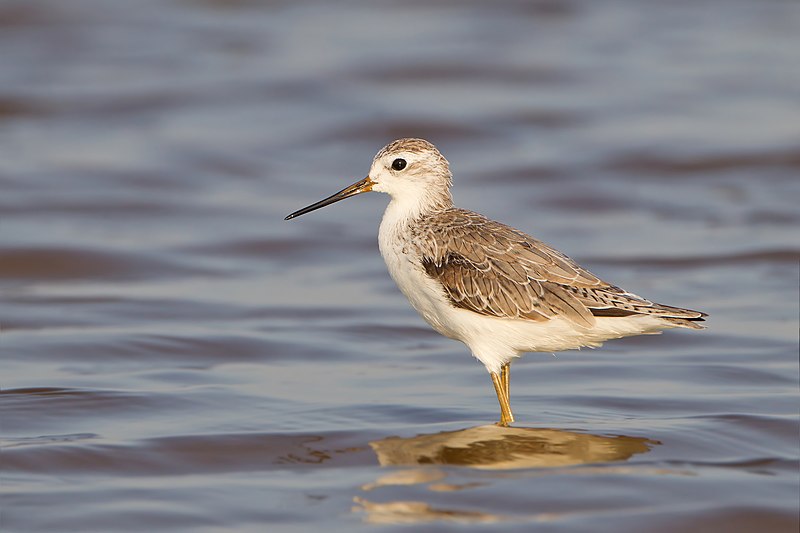
The Marsh sandpiper is a small wading bird that can be found in wetlands across easternmost Europe to the Russian Far East. They prefer open grassy steppe and taiga areas for breeding.
The genus name, Tringa, was given based on the Ancient Greek trungas, a white-rumped, tail-bobbing bird mentioned by Aristotle.
Marsh sandpipers are known to be rather small shanks and are distinct in their appearance.
They have a slim figure and slender legs that make them well-suited for moving through mud and water.
In addition to their physical characteristics, they also have a unique call that can be used for communication and attracting mates.
Overall, the Marsh sandpiper is an interesting and valuable bird species that plays an important role in its ecosystem.
Scientific classification:
| Kingdom | Animalia |
| Phylum | Chordata |
| Class | Aves |
| Order | Charadriiformes |
| Family | Scolopacidae |
| Genus | Tringa |
| Species | T. stagnatilis |
Also Featured In: Birds That Live in Iraq, Armenian Birds You Should Know
23. Pallas’s Grasshopper Warbler
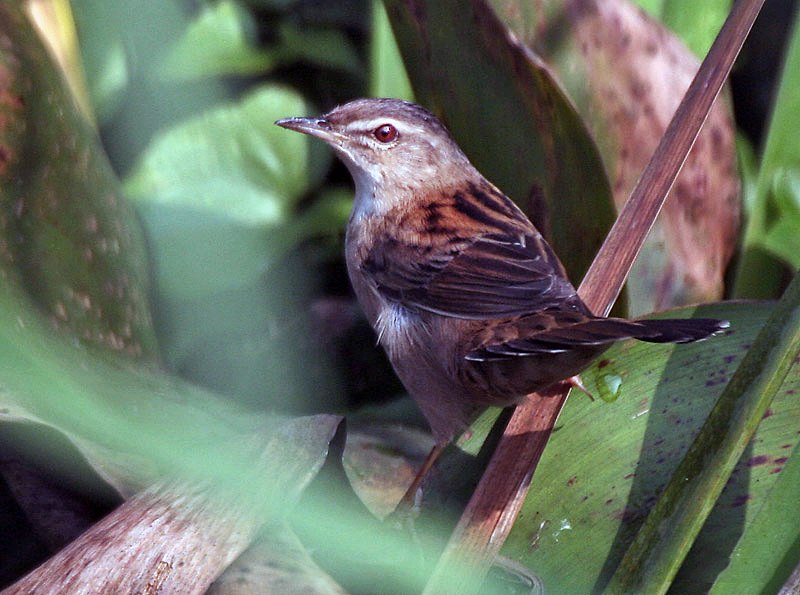
The Pallas’s grasshopper warbler, also known as the rusty-rumped warbler, is a migratory bird that breeds in the eastern Palearctic region.
It can be found in areas ranging from the Altai Mountains, Mongolia, and Transbaikalia to northeastern China and the Korean Peninsula, as well as islands located in the Sea of Okhotsk such as Sakhalin and Kuril Islands.
As its name suggests, the Pallas’s grasshopper warbler is similar to a warbler and is part of the grass warbler genus Helopsaltes.
During the winter months, this bird migrates to India and the surrounding areas.
Due to its migratory nature, the Pallas’s grasshopper warbler is often spotted in different parts of the world, making it a species of interest and importance for many bird watchers and conservationists.
Scientific classification:
| Kingdom | Animalia |
| Phylum | Chordata |
| Class | Aves |
| Order | Passeriformes |
| Family | Locustellidae |
| Genus | Helopsaltes |
| Species | H. certhiola |
Also Featured In: Common Uzbekistan Birds,
24. Rosy Starling
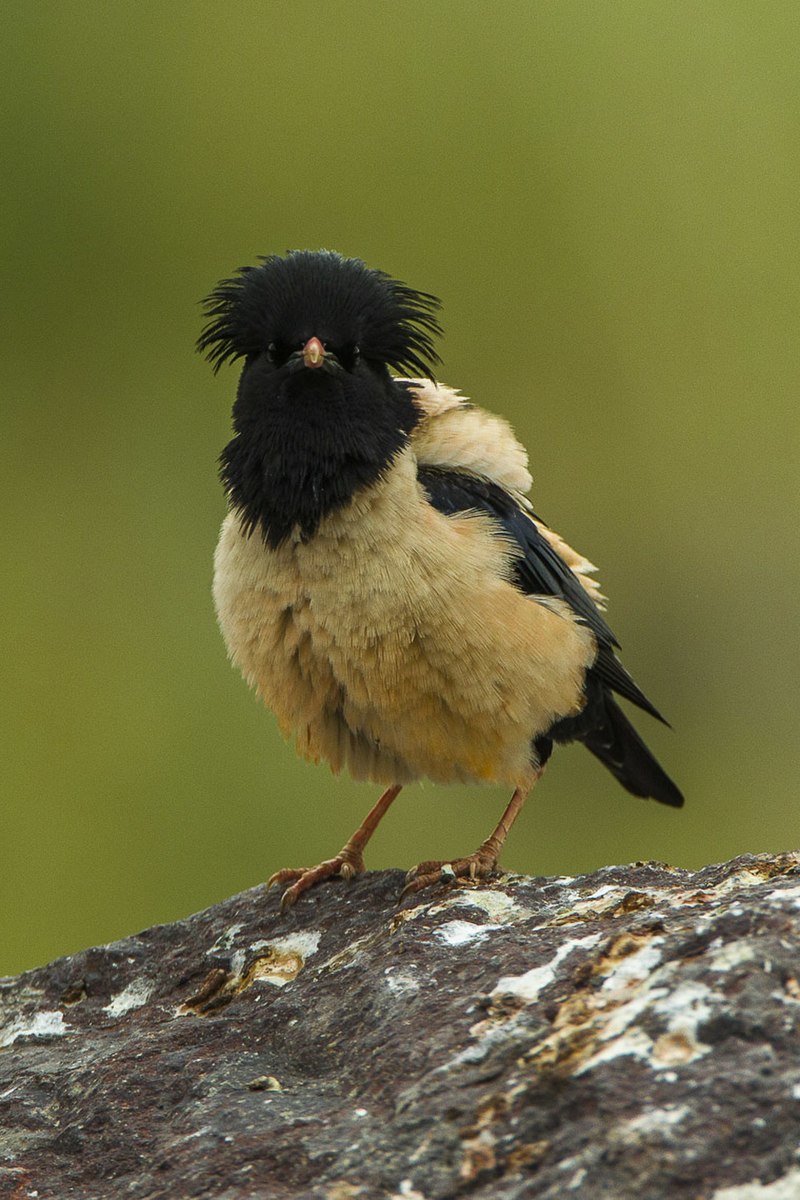
The Rosy Starling, also known as the Rose-coloured Starling or Rose-coloured Pastor, is a passerine bird that belongs to the starling family. It has recently been placed in its own genus, Pastor, and separated from Sturnus.
The bird got its name due to its rosy pink plumage. The Rosy Starling is a monotypic species, and its relationship with other related species is still under study.
The bird’s scientific name is Pastor roseus. In India, it is known as Gulabi Myna.
The Rosy Starling is native to East and Central Asia, and it has a wide distribution range that extends from Russia to India. It typically feeds on insects and seeds and can be found in fields, grasslands, and agricultural areas.
The Rosy Starling is a migratory bird that breeds in Europe and Asia and winters in South and Southeast Asia.
During breeding season, it can be seen in large flocks that build communal nests for breeding. The Rosy Starling is a beautiful bird that is widely appreciated for its striking appearance and pleasant song.
Scientific classification:
| Kingdom | Animalia |
| Phylum | Chordata |
| Class | Aves |
| Order | Passeriformes |
| Family | Sturnidae |
| Genus | Pastor Temminck, 1815 |
| Species | P. roseus |
Also Featured In: Common Serbian Birds,
25. Blyth’s Reed Warbler
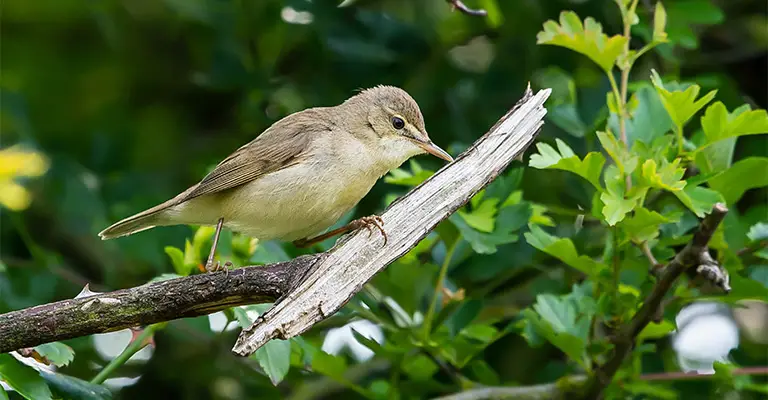
Blyth’s reed warbler is a migratory bird that breeds in the Palearctic and easternmost Europe. During winter, it is commonly found in Bangladesh, India, and Sri Lanka, where it is one of the most frequently seen warblers.
This species is a rare vagrant to western Europe. It is named after Edward Blyth, a British zoologist.
The bird belongs to the genus Acrocephalus and is considered an Old World warbler. Although it is widespread, little else is known about its behavior or habitat.
Overall, Blyth’s reed warbler is an interesting bird that migrates over long distances, making it a fascinating species to observe and study.
Scientific classification:
| Kingdom | Animalia |
| Phylum | Chordata |
| Class | Aves |
| Order | Passeriformes |
| Family | Acrocephalidae |
| Genus | Acrocephalus |
| Species | A. dumetorum |
Also Featured In: Common Estonian Birds, Common Birds in Bangalore
26. Asian Brown Flycatcher
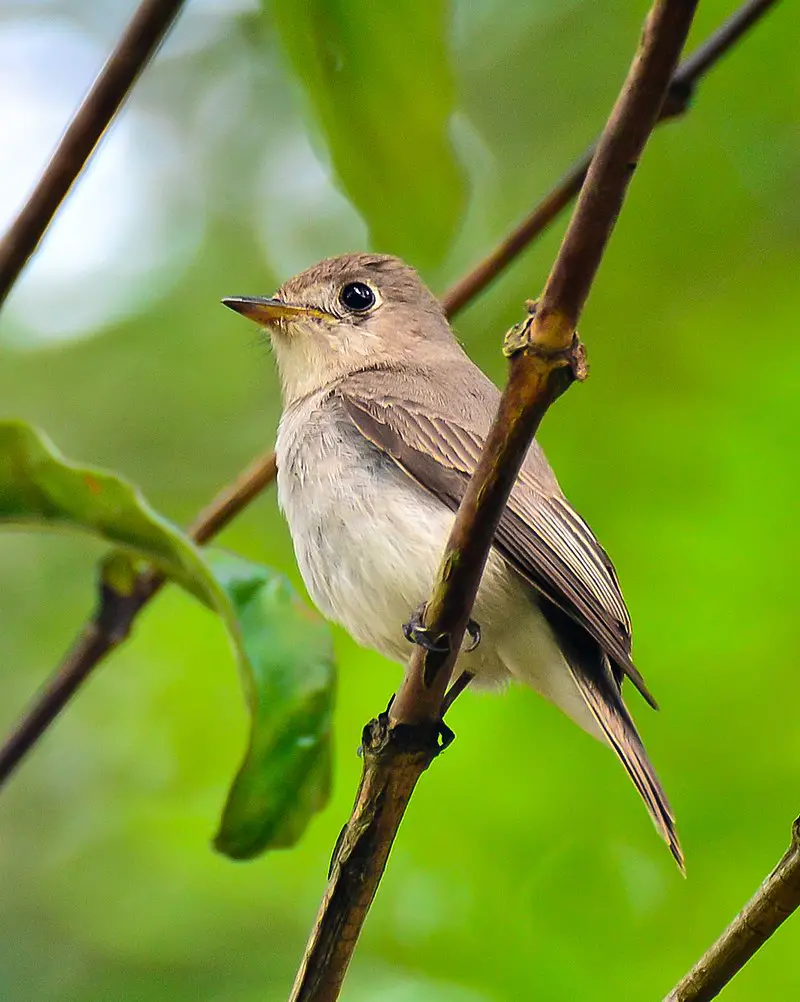
The Asian brown flycatcher is a small bird belonging to the flycatcher family Muscicapidae. Its name comes from the Latin words for “fly” and “catch.” This bird is found in Japan, eastern Siberia, and the Himalayas, and feeds primarily on insects.
Its scientific name, Muscicapa dauurica, refers to the Dauria region of south-eastern Siberia where it is found.
Known for its distinctive brown coloring, this bird is a favorite of birdwatchers and nature enthusiasts.
Despite its small size, the Asian brown flycatcher is an important part of the ecosystem, helping to control insect populations and contributing to biodiversity.
Scientific classification:
| Kingdom | Animalia |
| Phylum | Chordata |
| Class | Aves |
| Order | Passeriformes |
| Family | Muscicapidae |
| Genus | Muscicapa |
| Species | M. dauurica |
Also Featured In: Hong Kong Birds You Need to See, Urban Birds of Hong Kong
27. Indian Pitta
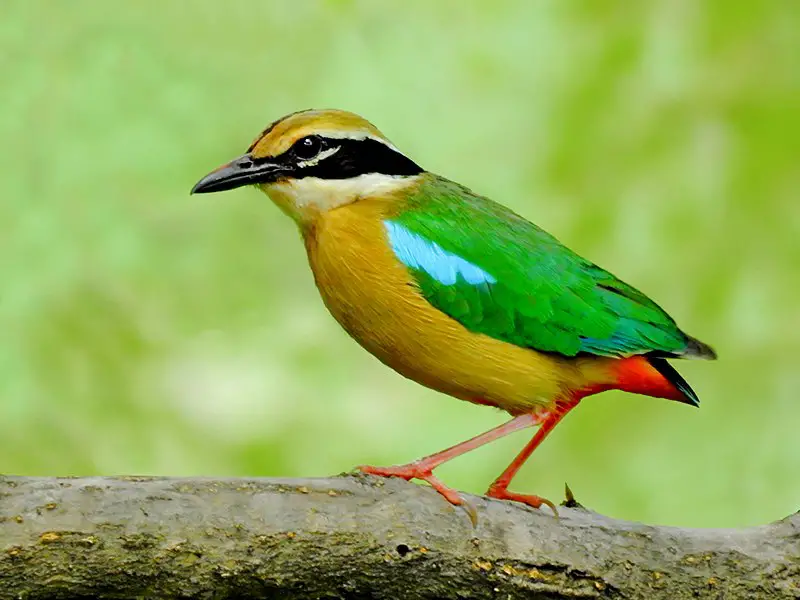
The Indian pitta bird is a beautiful passerine species found in the Indian subcontinent. It prefers to inhabit scrub jungle, deciduous, and dense evergreen forests.
During breeding season, it can be found in the forests of the Himalayas, hills of central and western India. However, it migrates to other parts of the peninsula during winter.
Despite its striking colors, the Indian pitta is quite shy and usually stays hidden in the undergrowth. It feeds on insects found in the forest floor.
This bird is an important part of the local ecosystems it inhabits and adds to the beauty and diversity of the region.
Scientific classification:
| Kingdom | Animalia |
| Phylum | Chordata |
| Class | Aves |
| Order | Passeriformes |
| Family | Pittidae |
| Genus | Pitta |
| Species | P. brachyura |
Also Featured In: Common Birds in Kerala, Most Common Madhya Pradesh Birds
28. Indian Blue Robin
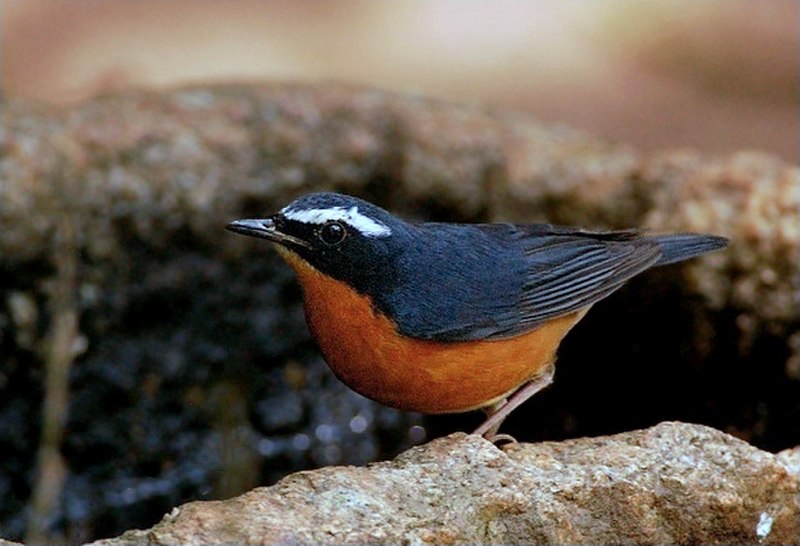
The Indian blue robin is a small migratory bird found in the Indian Subcontinent. It was once known as the Indian blue chat and is now considered one of the Old World flycatchers.
Breeding in the forests along the Himalayas of Nepal, India, Myanmar, and Bangladesh, the Indian blue robin winters in the hill forests of the Western Ghats in southern India. This bird is famous for its beautiful blue plumage, which gives it a unique look.
Though small, its appearance and unique migratory patterns make it an important part of the avian world.
Scientific classification:
| Kingdom | Animalia |
| Phylum | Chordata |
| Class | Aves |
| Order | Passeriformes |
| Family | Muscicapidae |
| Genus | Larvivora |
| Species | L. brunnea |
29. Brown-Breasted Flycatcher
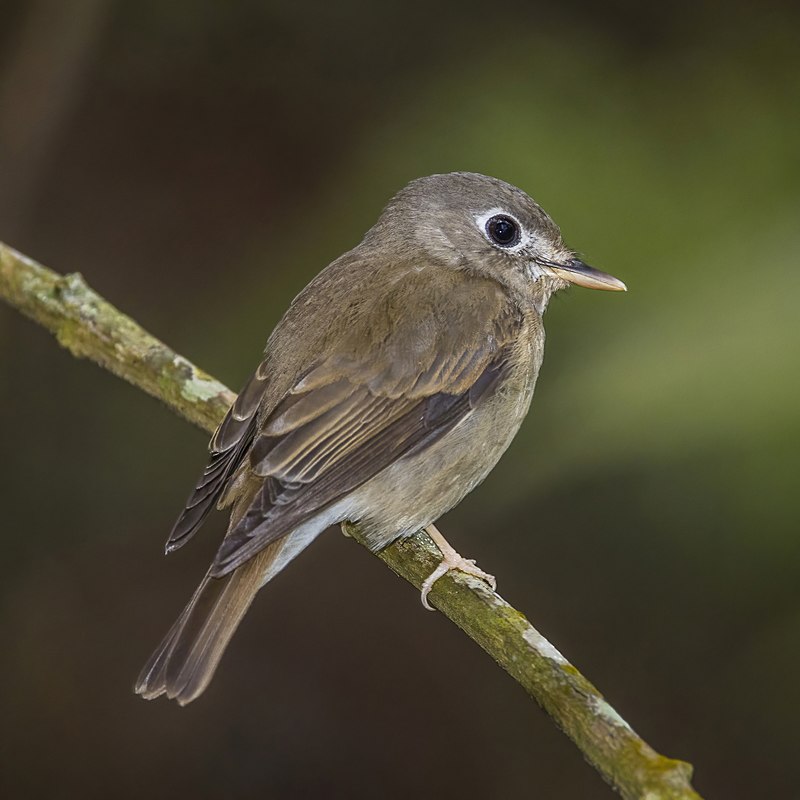
The Brown-breasted Flycatcher is a small bird that belongs to the Muscicapidae family. This species is found in northeastern India, central, and southern China, Burma, and Thailand, and migrates to southern India and Sri Lanka.
These birds feed on insects and often forage below the forest canopy near the forest floor. They have a brown breast and are also known as Layard’s Flycatcher. These birds are passerine and are known for their distinctive beaks.
They can be found in forests and wooded areas and are migratory birds. These birds are small in size and are a treat to watch in their natural habitat.
The Brown-breasted Flycatcher is an important part of the ecosystem and helps in insect control.
Scientific classification:
| Kingdom | Animalia |
| Phylum | Chordata |
| Class | Aves |
| Order | Passeriformes |
| Family | Muscicapidae |
| Genus | Muscicapa |
| Species | M. muttui |
30. Long-Toed Stint
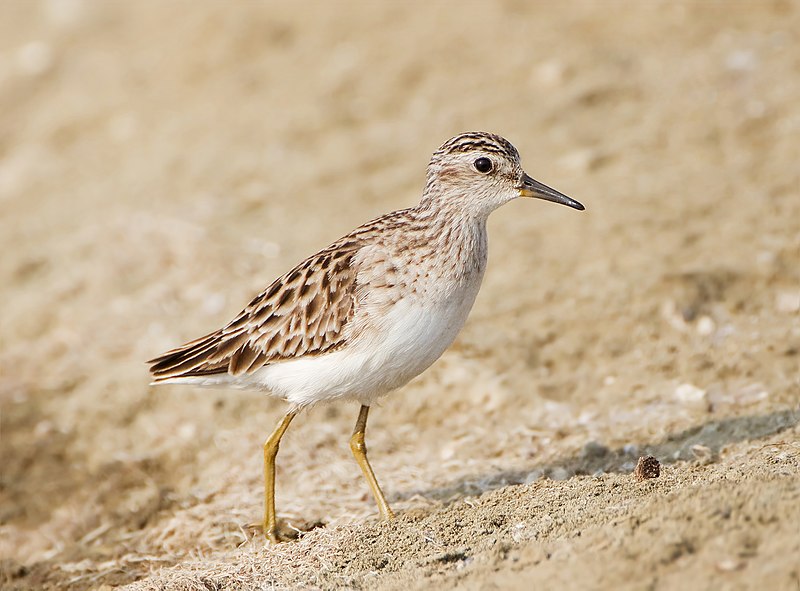
The Long-toed stint is a small wading bird that breeds in the northern regions of Asia. This bird has been given its name due to its lengthy toes, which help it move easily through the marshy environments it inhabits.
It undertakes a long, treacherous migration route, with many individuals travelling down south during the winter months.
The name Calidris subminuta derives from the Greek kalidris, a term used by Aristotle for certain greyish waterside birds.
The bird is quite similar in appearance to the little stint, Calidris minuta, hence the use of the word “minuta” in the specific name.
Altogether, the Long-toed stint is an admirable yet vulnerable species, and efforts must be made to protect its habitat to ensure its continued existence.
Scientific classification:
| Kingdom | Animalia |
| Phylum | Chordata |
| Class | Aves |
| Order | Charadriiformes |
| Family | Scolopacidae |
| Genus | Calidris |
| Species | C. subminuta |
31. Richard’s Pipit
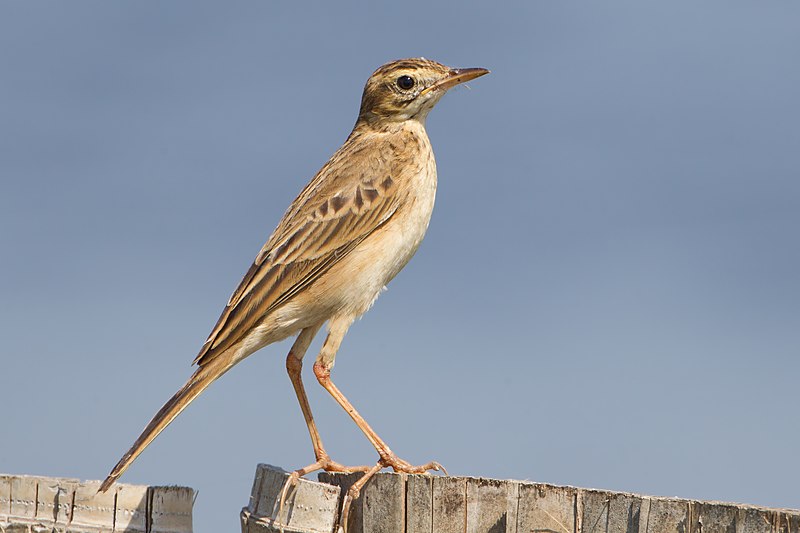
Richard’s pipit is a medium-sized bird found in East Palearctic grasslands. It is a seasonal migrant that travels long distances to open lowlands in the Indian subcontinent and Southeast Asia.
Western Europe occasionally observes this bird as a rare but regular vagrant. The bird’s name comes from the Latin word for a small grassland bird, Anthus. Its specific name, richardi, honors the French naturalist who first described this bird.
The Richard’s pipit is known for its distinctive call, which is a high-pitched and musical series of notes.
This bird typically feeds on insects and other invertebrates found in open grasslands. Its breeding behavior is well-studied, but much remains to be learned about its migration patterns and ecology.
Scientific classification:
| Kingdom | Animalia |
| Phylum | Chordata |
| Class | Aves |
| Order | Passeriformes |
| Family | Motacillidae |
| Genus | Anthus |
| Species | A. richardi |
32. Large-Billed Leaf Warbler
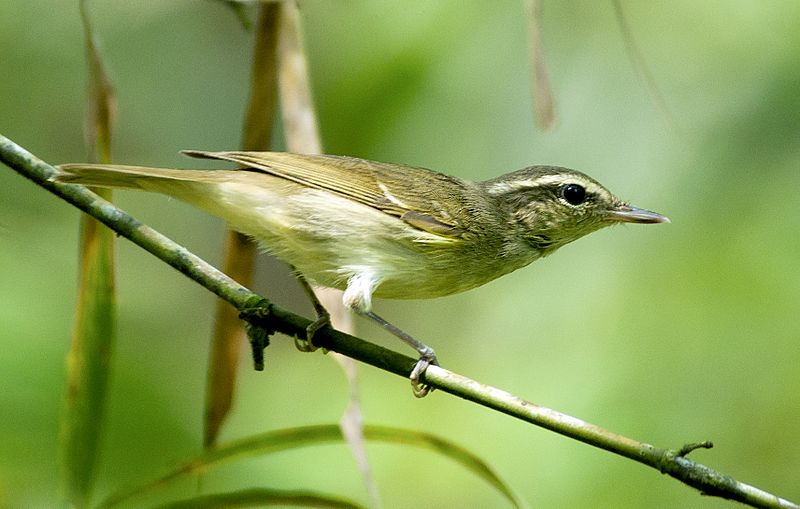
The large-billed leaf warbler is a species of leaf warbler found in central China and the Himalayas. During winter, it migrates to the Western Ghats and surrounding hill regions.
This bird thrives in dense vegetation and is generally heard more often than seen. Its two-note dir-tee call is distinct, with the second note being much higher in pitch.
The large-billed leaf warbler was previously classified as part of the “Old World warbler” group, but now belongs to the family Phylloscopidae.
Despite its elusive nature, this bird is known for its impressive bill.
Overall, the large-billed leaf warbler is an interesting species that inhabits some of the world’s most beautiful and diverse regions.
Scientific classification:
| Kingdom | Animalia |
| Phylum | Chordata |
| Class | Aves |
| Order | Passeriformes |
| Family | Phylloscopidae |
| Genus | Phylloscopus |
| Species | P. magnirostris |
Conclusion
Sri Lanka serves as a vital destination for a diverse array of migrating bird species, attracting around 32 notable avian migrants annually.
These birds traverse vast distances, utilizing Sri Lanka’s varied habitats from coastal wetlands to inland forests as crucial stopover points or wintering grounds.
The island’s strategic geographical location along major migration routes facilitates this influx of avifauna.
The presence of diverse ecosystems provides essential resources such as food and shelter, supporting the survival and well-being of these migratory birds.
Conservation efforts aimed at protecting these habitats and addressing potential threats like habitat loss, climate change, and pollution are imperative to ensure the continued presence of these migratory species in Sri Lanka.
Through concerted conservation endeavors, Sri Lanka can maintain its status as a significant haven for migratory birds while fostering global biodiversity conservation.